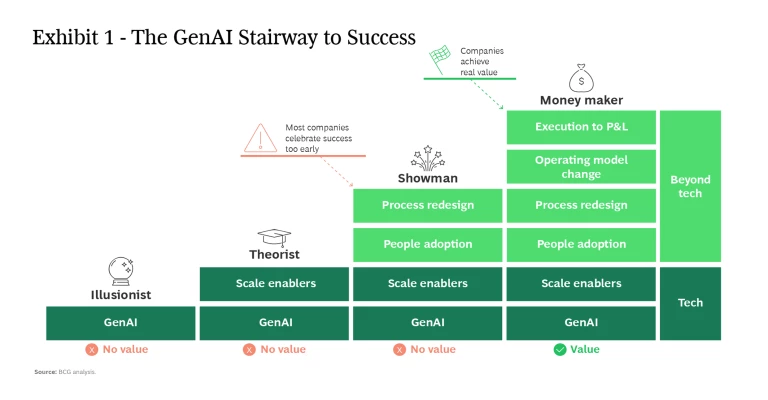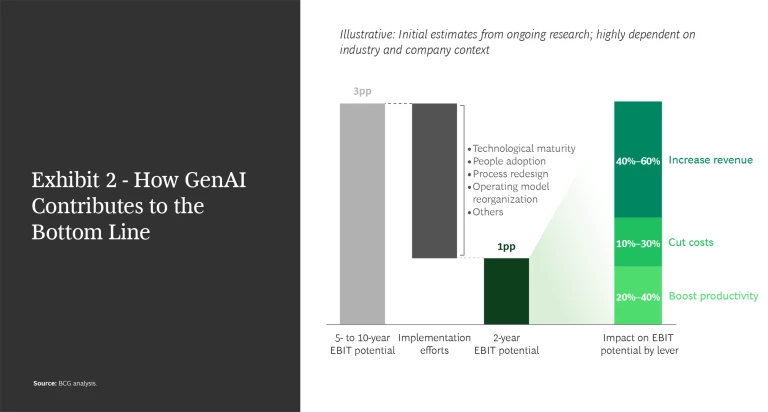In business technology , generative artificial intelligence ( GenAI ) is often seen as a new miracle engine that promises to put early adopters on the track to greater efficiencies, lower costs, and quick wins. But most companies find that after a year of investing in endeavors that have underdelivered compared with expected results, the effect seems more like a collective spinning of wheels.
In addition, many organizations have celebrated their success too early, before realizing benefits that show up on the bottom line. As a result, the perceived effects evaporate before they can be substantiated. According to a recent BCG survey, 66% of executives said they are dissatisfied with their company’s progress in GenAI . Companies should not give up too soon, however; 54% of respondents still expect the technology to deliver cost savings in 2024. The risk is that disappointed expectations can lead to disillusionment and lost momentum, when there are real benefits to be had.
Setting Your Company Up to Succeed with GenAI
BCG’s experience with clients suggests many businesses are failing to realize value from GenAI because they lack a structured approach and clear value focus from the onset. Specifically, companies have treated GenAI like a typical technology upgrade or a collection of pilots, with tech teams leading the way. While this is fine for the technology side of the equation, it fails to achieve real bottom-line impact. In fact, GenAI requires an even higher level of craftmanship than other types of transformation. It needs a greater focus on critical enablers like process and operating-model redesign, training, and employee adoption—factors that are often overlooked—as well as measurable P&L or balance sheet improvement goals.
Visible support from leadership is an important success factor in GenAI transformations.
Visible support from leadership is an important success factor. GenAI transformations need to be led from the C-level, and business unit and functional leaders must be accountable for generating value creation levers and achieving results. This can help propel the holistic, people-driven transformation that is required, with specific EBIT (earnings before interest and taxes) targets that are actionable and traceable.
From our work on more than 350 GenAI projects for clients, we have learned that the key is to target EBIT gains from the outset, not just focus on an implementation program that companies hope will mature into a value creator. BCG has identified a “GenAI stairway” with four stages that organizations must move through smoothly to get from GenAI illusion to economic impact. (See Exhibit 1.)

Stage 1: Illusionist
In this stage, companies across all industries embark on the GenAI journey, attracted by promised efficiency gains from tools like ChatGPT, Microsoft Copilot, or customized chatbots. We have seen examples of more than 100 use cases where organizations were running pilots in many departments but without a clear definition of user needs and without considering technological synergies across functions.
Unfortunately, such isolated deployments fail to generate tangible value because they lack a strategic plan for employee training and enterprise-wide scaling, leaving the impression that GenAI benefits are just an illusion.
Stage 2: Theorist
Scaling beyond a few limited tools is necessary, given that meaningful value can come only from meaningful scale. But we find that most companies that try to scale GenAI throughout the enterprise struggle with low user adoption. Often, employees feel excluded and do not receive sufficient training; as a result, they fail to incorporate the tool effectively into their workflow and the GenAI value remains out of reach.
Stage 3: Showman
As companies struggle with the complexities of GenAI deployment, some realize that success requires more than just implementing tools. Leading organizations adopt the 10/20/70 principle, referring to how companies should apportion time and resources, recognizing that, while algorithms (10% of the effort) and technology (20%) are essential to a GenAI implementation, people and process changes (70%) require the most attention. Companies that invest in training and change management can typically achieve an adoption rate of about 60% across the enterprise, in our estimation, compared with 30% for those that do not invest in these areas.
Organizations that have successfully undertaken holistic process and workflow changes report efficiency gains of up to 50%. But celebrating at this stage is premature. Our follow-up with these clients reveals that, within a few months, the initial gains tend to dissipate as employees’ new free time becomes occupied with backlog tasks or other emerging priorities. So, while this stage is a significant milestone, it is not enough to drive lasting value.
Stage 4: Money Maker
The final, essential, step to achieving measurable value from GenAI is to establish clear links between efficiency gains and the P&L statement and diligently execute an EBIT-focused transformation.
Companies have a variety of challenges to address with GenAI, and there are numerous potential strategies to convert efficiency gains to actual profit. In one recent example, BCG worked with a client to help identify 69 different process “value packages,” which are high-impact use cases with clear EBIT potential, execution milestones, and trackability. These vary from automated product management and competitor intelligence in the marketing department, to improving the accuracy and speed of decision making in the finance function. Other use cases include reassigning employees to new tasks, streamlining inventory management, and improving customer relations to drive top-line growth.
For any GenAI strategy, organizations need to establish at an early stage how efficiency gains will impact the P&L and then follow up with a structured end-to-end transformation. Companies should create a GenAI transformation office to safeguard value through target setting, tracking, enablement, and accountability enforcement. This allows the business to truly complete its GenAI journey and achieve the status of GenAI money maker without getting stuck along the way.
Putting It All Together
The stairway highlights that only the first step is solely about the technology. Many companies have moved beyond tech but are stuck between the second and third steps of GenAI adoption. Their experience has been one of experimentation, and while partial steps might help bring intangible improvements, such as increasing working satisfaction for employees, these actions ultimately lack significant EBIT impact. We call this “creative GenAI chaos.”
To escape the chaos and bring structure to the implementation, companies must define EBIT impact targets from the beginning. The magic of targets comes from imposing a structure and discipline that help maintain focus and guide the project to a successful result.
Three key value creation levers can impact the bottom line (see Exhibit 2):

- Revenue. Companies can improve revenue in various ways, including through salesforce productivity increases and the introduction of smart-pricing mechanisms. An example is a leading fashion company we worked with that uses GenAI to boost customer engagement by making personalized product recommendations, an initiative that is expected to raise sales by several million euros.
- Expenditures. Spending can be reduced, for instance, by using GenAI tools to help manage supplier negotiations or create marketing assets in-house, rather than contracting with an agency. In one relevant case, we helped a leading beverage company address its marketing spending by harnessing GenAI to develop new marketing assets. The procurement team was able to use GenAI in negotiations to achieve better discounts by leveraging far more data than humans can handle alone and by extending the reach to smaller “tail” suppliers, leading to an estimated 80% agency cost savings.
- Productivity. Streamlining workflows can boost internal productivity. For example, we helped a leading German, publicly listed (DAX-40) company use GenAI to write request-for-proposal documents, resulting in a savings of up to ten hours per RFP.
Organizations can achieve the full potential of GenAI only by establishing a proper value realization mechanism. They should start by setting top-down targets based on an assessment of GenAI’s potential to impact the three value areas. In addition, it is essential to implement a rigorous process to prioritize high-potential GenAI use cases and establish accountability. Companies can validate progress and achievements from the bottom up, for example, by conducting workshops to identify value packages. A proper change management program will be required, too, because the transformation will significantly impact organizational culture. The final step is to establish a transformation office to help execute the implementation roadmap, proactively manage roadblocks, establish governance structures, and track the progress and impact of specific value packages and the overall program.
We have seen GenAI transformations yield a 1- to 2-percentage-point increase in revenue and an 8% to 12% cost reduction compared with the baseline. Companies can potentially achieve a return on investment of 10 to 15 times in less than three years. For example, BCG worked with a client to achieve an EBIT impact of over 10% by evaluating more than 50 GenAI value packages. In another case, we helped identify GenAI use cases that a client is putting into practice to capture up to €1 billion in potential EBIT impact by 2028.
When it comes to implementing GenAI, possibly the most significant technology advancement of our generation, leaders need to be realistic in the face of excessive hype and expectations. GenAI is bound to impact all companies in all industries, but only those that can implement it with a focus on process, people, and organizational culture—not just technology implementation—will emerge with real success in terms of greater profitability. A successful transformation begins with identifying realistic EBIT goals and establishing measures such as a GenAI transformation office to hold key people accountable. The right steps at the outset of the GenAI journey can keep leaders focused on bottom-line impact and avoid celebrating their success too early.
The authors thank Nicolas de Bellefonds, Lucas Christenson, Elias Kurta, Tobias Messmer, Benedikt Neininger, Felix Prosenz, Maximilian Tischer, Paul Worm, and Katharina Wortberg for their invaluable contributions to this article.











